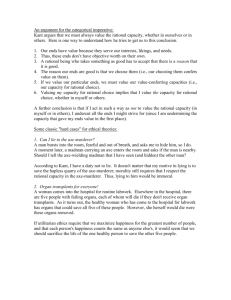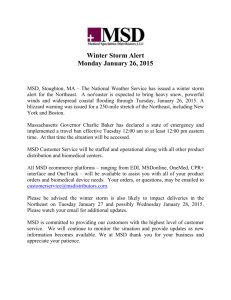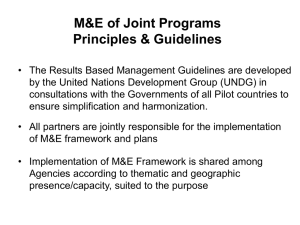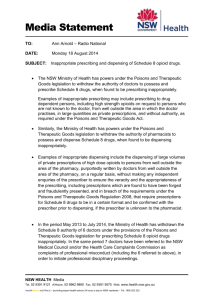Medical Supplies (Including Drugs) - Ministry of Health, Nutrition
advertisement
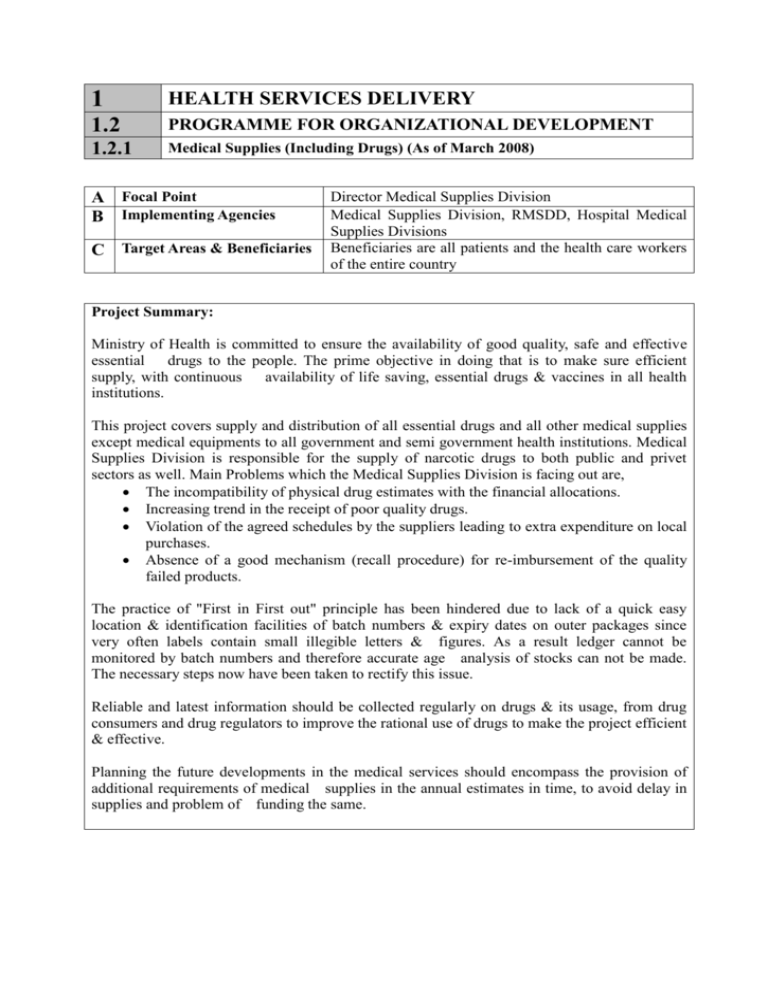
1 HEALTH SERVICES DELIVERY 1.2 PROGRAMME FOR ORGANIZATIONAL DEVELOPMENT 1.2.1 Medical Supplies (Including Drugs) (As of March 2008) A Focal Point B Implementing Agencies C Target Areas & Beneficiaries Director Medical Supplies Division Medical Supplies Division, RMSDD, Hospital Medical Supplies Divisions Beneficiaries are all patients and the health care workers of the entire country Project Summary: Ministry of Health is committed to ensure the availability of good quality, safe and effective essential drugs to the people. The prime objective in doing that is to make sure efficient supply, with continuous availability of life saving, essential drugs & vaccines in all health institutions. This project covers supply and distribution of all essential drugs and all other medical supplies except medical equipments to all government and semi government health institutions. Medical Supplies Division is responsible for the supply of narcotic drugs to both public and privet sectors as well. Main Problems which the Medical Supplies Division is facing out are, The incompatibility of physical drug estimates with the financial allocations. Increasing trend in the receipt of poor quality drugs. Violation of the agreed schedules by the suppliers leading to extra expenditure on local purchases. Absence of a good mechanism (recall procedure) for re-imbursement of the quality failed products. The practice of "First in First out" principle has been hindered due to lack of a quick easy location & identification facilities of batch numbers & expiry dates on outer packages since very often labels contain small illegible letters & figures. As a result ledger cannot be monitored by batch numbers and therefore accurate age analysis of stocks can not be made. The necessary steps now have been taken to rectify this issue. Reliable and latest information should be collected regularly on drugs & its usage, from drug consumers and drug regulators to improve the rational use of drugs to make the project efficient & effective. Planning the future developments in the medical services should encompass the provision of additional requirements of medical supplies in the annual estimates in time, to avoid delay in supplies and problem of funding the same. 1. Justification: The Medical supplies division (MSD) is managed directly by the Line Ministry and is responsible to ensure timely and smooth distribution of drugs and selected medical supplies. Although Sri Lankan health system is decentralized, the countrywide requirement of drugs and medical supplies are purchased centrally by the MSD through the State Pharmaceutical Corporation. Depending on the demand and estimated requirements, quarterly requirement is distributed to 26 Regional Medical Drug Stores located in 26 health districts. Unavailability of a complete logistical management information system at the Medical Supplies Division has become a hindrance to ensure the discharge of its services, timely, effectively and efficient manner. The project will enable MSD to develop a medical supplies management information system for better productive procurement and supply system, by promoting the rational use of drugs. 2. Important Assumptions/Risks/Conditions: Assumptions. Proper and timely estimation of medical supplies by end users, in consistent with the financial allocations for better planning and utilization of as resources. Rational use of drugs will be practised by prescribers, Pharmacists & Patients. Risk. Impact of the ability to supply a required product in required quality, quantity and time. Not being able to supply according to delivery schedules. Quality failed drugs can enhance the possibility of out of stock situation. Conditions. MSD should compensate for the additional expenditure incurred due to violation of the delivery schedule by the supplier. STG should be developed & adopted wherever possible. Provincial authorities & line ministry should work out a common system for procurement of equipments which requires similar consumables & disposables for functioning of the same. 3. Project Objective: Objective To improve management of medical supplies distribution through effective information system & improve rational use of drugs. Formulation of Policies, guidelines & plans for drug procured by and donated to, the Ministry of Health and implementation of same. Strengthening drug regulation procedure including good manufacturing practices and law enforcement Indicators Means of Verification % of essential drugs being out By surprised test check of stock in a given period at any reports. dispensing By feed back outlet(OPD-pharmacy, Ward information received via etc). monthly returns. No of drugs/consumables being By quality failed drug out of stock at different level of register. stores at each month. By DTCC reports. Cost of local purchases of drugs by institutions. No & % of the consignments of the items failed. in quality per annum. Drug- use indicators such as mean number of drugs per encounter,% of prescriptions with antibiotics, % of prescriptions with generics etc. The following policies have Approved National been formulated within 6 Drug Policy and Policy months after adoption of the on Donations of Drugs Health Master Plan and & Bio-medical approved by the Cabinet within Equipment. 3 months thereafter Approved Implementing 1) National Drug Policy Guidelines and Plans. 2) National Policy on Medical Approved Provincial Supplies Other than Drugs Implementation Plans. 3) National Policy on Minutes of meeting of Donations of Drugs & Medical Medical Supplies equipment Coordination Implementing Guidelines and Committee. Plans within 6months from the above policy formulations. Formulation of Provincial Implementation Plans for the above mentioned policies. Periodic review of the Policy, and Implementation of the Guidelines and Plans by Medical Supplies Coordination Committee. Number & % of law Enforcement reports. enforcement action on the reported incidents of breaking the regulations. Number & % of law through Strengthening of drug regulatory authority. enforcement action successfully completed. Test reports accredited by Reports and returns. National Drug Quality Assessment reports. Assurance Laboratory. Test reports obtain from reputed independent laboratories. Establishment of a well Drug expiry reports and Age Expired drug register. coordinated logistical analysis of the stock. supply The value & % of the system and good expired/obsolete stock from pharmaceutical that of the serviceable stock. Procurement system. Providing adequate Total manpower requirement Monitoring Reports. human, financial & for Medical Supplies units as physical (space & a % of total approved cadre, % transport) resources, for of total cadres filled up and % acquisition and better of the number of staff trained management of medical from the total in attaining the Supplies. required norms. Expenditure on medical supplies in line ministry and decentralized nits/ institutions as a % of total expenditure respectively. (capital and recurrent costs). Space available for medical supplies in the stores & in the hospitals within the system, as a % of space required for storing quarterly requirements Continuous promotion of % of randomly selected Prescription review. Scientific rational prescriptions that comply with Observation. prescribing, good prescribing practices. Public perception dispensing & use of % of encounters with good survey medicines dispensing practices from a DTCC reports. continually promoted in randomly selected patient the public & private population. sectors. % of public with knowledge, attitudes and practices that reflect, rational use of medicines. Ensure the availability of quality, safety and effective Pharmaceuticals.


